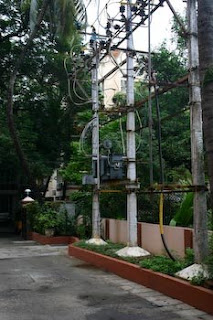
A mere 3 ½ hours after arriving at my apartment, I was boarding a school bus to the Ideal Beach Resort, located outside the historical city of Mahabalipuram, about 40 km away from Chennai. Following a shaded road to the hotel buildings, we were welcomed with a garland of jasmine flowers. Walking towards the hotel room the school rented for the day, I noticed how new all the buildings looked. This was one of the areas affected by the tsunami of 2004.
Walking along the sandy beach, I scanned the horizon of the sea. In the distance, fisherman braved the rough seas in boats hewn from logs. Along the shore, colorful boats and weathered log boats lined the beach for quite a distance. A few fishermen were mending their nets, using their toes to facilitate the process. Next to the hotel’s’ beach area, small fishermen’s huts were built a distance away from the shore. I wonder if these simple dwellings were all built post 2004, not to mention how the tsunami must have affected the livelihoods of these people dependent on the sea.

Along the warm golden sand, I spotted the carcasses of several ocean creatures, including several puffer fish, red snapper, and eels. Young men posed for a camera with the fish carcass they had used to create their version of a sand castle. Crabs scuttled, camouflaged by the sand, popping into a vast network of small sand holes. Cows lounged around on the beach, also seeming to enjoy a holiday. In the distance, more thatched huts were visible next to a more forested section. A Hindu man with his Christian wife approached us, eager to sell the bedspreads made from used
saris (traditional Indian woman's dress). Although colorful and clever, neither one of us had brought any money - an easier (but truthful) way to decline buying anything.
After an enjoyable brunch consisting of both Western and Indian

foods, I took a swim in the hotel’s pool – cleaner and free of dangerous rip tides than the nearby sea. Others relaxed in lounge chairs around the large pool. Rather quiet when I arrived, the pool area was later filled with the sounds of multiple languages and children splashing. There were quite a number of Korean families. It is likely that many of these will be attending the American International School in Chennai where I work. Knowing I had enough sun exposure, I decided to sit in the shade for a while. Eyeing an ice cream bar one of the Korean kids was eating, I also decided to get one – a wonderful treat on a humid day.
I then took a walk through the grounds of the resort. Flowers and plants lined the walkways. Palm trees dotted the lush lawn. Large white statues of Hindu gods contrasted sharply from the colorful surroundings, seemingly not part of the same world. Butterflies danced in the air, fluttering to the flowers in the trees and ground. Construction, most of it done by hand, was underway, with more landscaping and buildings developing.

After another walk on the beach and driveway, it was time for us to return to Chennai. I was eager to unpack my suitcases from that morning. With its closeness to Chennai and tranquility difficult to find in the city, this would be a nice place to visit for the weekend. I will then have to visit the famous granite carvings of Mahabalipuram.
 Blessed with a long coastline, one of Chennai’s beaches is known as Elliot’s Beach, located in the neighborhood of Besant Nagar. Since I was already in Besant Nagar for the Velankanni church festival, I went to the beach there, meeting up with a colleague who lived nearby. Approaching the beach through a narrow path, it appeared as though the groun
Blessed with a long coastline, one of Chennai’s beaches is known as Elliot’s Beach, located in the neighborhood of Besant Nagar. Since I was already in Besant Nagar for the Velankanni church festival, I went to the beach there, meeting up with a colleague who lived nearby. Approaching the beach through a narrow path, it appeared as though the groun d-covering of green plants with pink flowers went right up to the sea.
d-covering of green plants with pink flowers went right up to the sea. e water running over our feet, with a surge quickly getting the bottoms of our capris wet. Further up the sandy shore people ventured into the water, the women in their saris.
e water running over our feet, with a surge quickly getting the bottoms of our capris wet. Further up the sandy shore people ventured into the water, the women in their saris. uitous sport of India. Vendor stalls were quite on the Sunday morning. Right across the street from a line of shops and cafés were some simple homes woven from palm fronds. As with other parts of Chennai, the contrast between the classes in the same neighborhood was quite distinct.
uitous sport of India. Vendor stalls were quite on the Sunday morning. Right across the street from a line of shops and cafés were some simple homes woven from palm fronds. As with other parts of Chennai, the contrast between the classes in the same neighborhood was quite distinct.



































